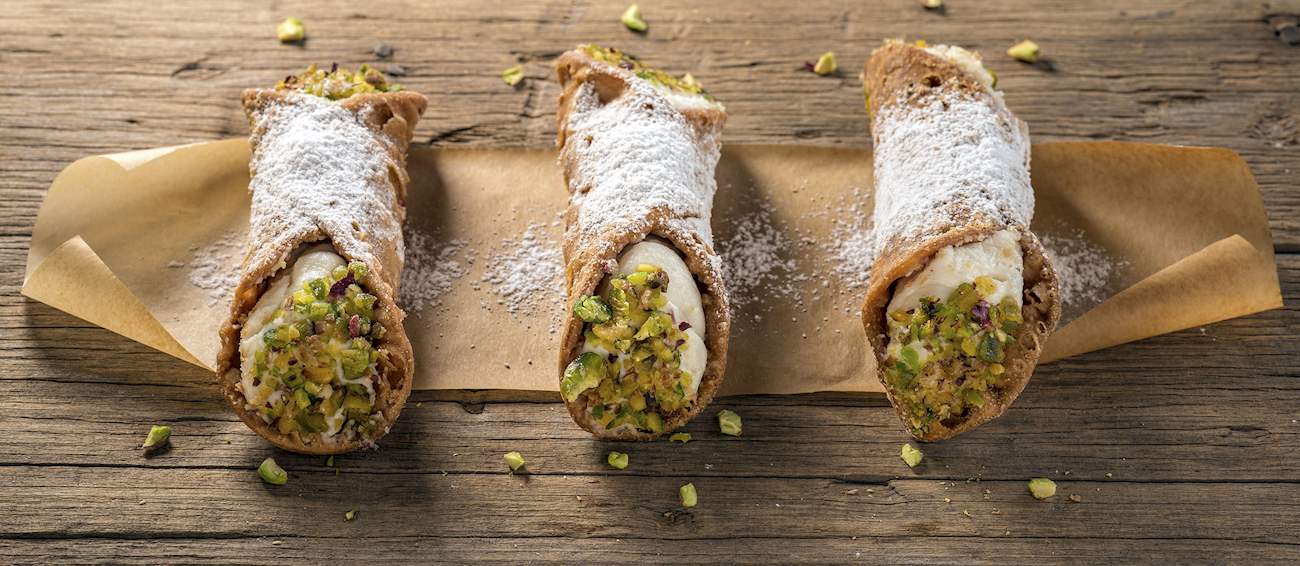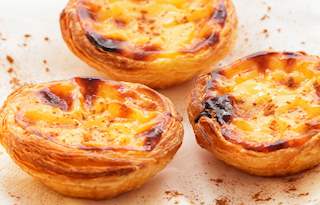(Cannoli Siciliani)
These decadent, crispy fried pastry tubes filled with luscious ricotta cheese cream are perhaps one of Sicily's best known desserts outside of Italy. Cannoli are believed to have originated around Palermo during the 9th century, while Sicily was under Arab rule.
Legend has it that they were originally prepared by the women of the ancient city of Qal'at al-Nisā' (lit. castle of women), the modern-day Caltanissetta, which at the time served as the harem of a Saracen emir. Later on, the recipe later somehow found its way to the monasteries of Palermo where nuns would prepare this lavish dessert during the carnival season.
Cannoli have come a long way since then, becoming incredibly popular not only throughout Italy, but also in North America, where they were introduced by Sicilian immigrants in the late 19th century. Furthermore, thanks to one of the most famous lines from the movie The Godfather — "Leave the gun. Read more
Take the cannoli." — by the end of the 1970s, this dessert had attained a truly iconic status. Although people in the United States are familiar with different variations of this classic recipe, cannoli in Sicily are still prepared in a more traditional way.
The crispy pastry shells are typically flavored with cocoa, suet, and Marsala wine, while the delicate freshness of the sweetened ricotta is sometimes enriched with orange blossom water, candied orange peel, chocolate, zuccata candied pumpkin, or finely chopped pistachios.
The name is derived from canna, a cane reed that’s cut into sections and used as a mold for frying the pastry shells, although metal cylinders have mostly replaced canna nowadays. And last, but certainly not least, cannoli shells are always filled just before serving to prevent them from getting soggy, ensuring the perfect feel of crunchiness against the creamy filling.
Recipe variations
Traditional Cannoli Siciliani
READY IN 5hAdapted from VisitSicily.info, the official tourism website of Sicily, this recipe gives instructions on how to prepare the authentic Sicilian cannoli.
Cannoli Siciliani with Chocolate
READY IN 4h 10minThis recipe was adapted from Manu's Menu, a food blog about traditional Italian cuisine through which Manuela Zangara shares her passion for food and spreads the concept of authentic Italian home-cooking through step-by-step tutorials. On her blog, she shares her family’s recipe and makes the classic Sicilian cannoli from scratch, including the preparation of pastry shells.
Cannoli Palermitani
READY IN 14h 20minThis recipe is adapted from Rosetta Costantino, a native Calabrian, author of Southern Italian Desserts, cooking teacher, and expert. She managed to trace this classic 1950s cannoli recipe to the famous Caflisch Café, which is even today one of Palermo’s most popular pastry shops. Costantino’s recipe features cannoli shells flavored with Marsala and red wine vinegar, while the Palermo-style ricotta filling is the simplest one. Still, the recipe can easily be adjusted to anyone’s liking.
Cannoli Authentic recipe
Adapted from VisitSicily.info, the official tourism website of Sicily, this recipe gives instructions on how to prepare the authentic Sicilian cannoli.
WHERE TO EAT The best Cannoli in the world (according to food experts)

"Try the exquisite cannoli in the leafy back garden."
"Fortunately the cannoli were as good as I’d heard. Each cannoli is deep-fried in lard and stuffed with sweetened sheep’s milk ricotta, bits of candied orange, and a few chunks of chocolate, and are made to order so the shells stay nice and crisp."
"Cannolissimo: it is always the best time to eat a fantastic Sicilian cannoli, especially if they also make it gluten-free and in the center."
"Dinnertime was rolling near, but it was hard to resist one last treat: a cannoli with cow’s milk ricotta (shown at the top of the post), which they told me was a southern Sicilian thing, different from the sheep’s milk ricotta used in the north of Sicily. The smoother cow’s milk ricotta was more refined, less-grainy."
"Afterwards, go for one of the very best cannoli you've ever had at Savia. It's an institution that's open from 8am until 9.30pm and serves perhaps the best espresso in town."
"Pop in for delectable homemade sweets such as cannoli freshly filled with ricotta."
"The whole cannolo is pretty fantastic, as a subsequent visit revealed."
"The best places will fill your cannoli after you order it. If you’re in the Sicilian pastry’s homeland, try the Laboratorio Pasticceria Roberto in Taormina."
"Needless to say that the classic Sicilian cakes are the ones that attract, and after the granite it is the turn for cannoli, with a special refinement for the lightness of the ricotta and well-crafted as the subtle and fragrant wafer."
"Top 5 Sicilian Cannoli: Irrera 1910 - It's recognized by the soft and sweet ricotta since the year that indicates its name. The cannoli are freshly filled, so the dough doesn't get wet. They decorate them with pistachio or almonds."






































